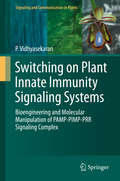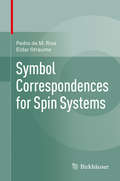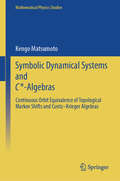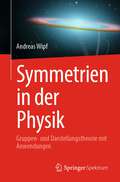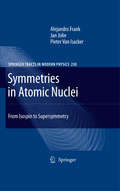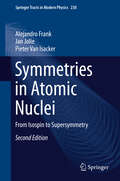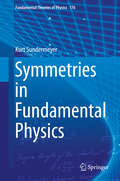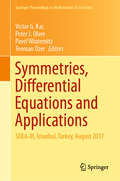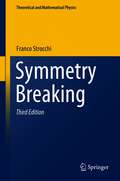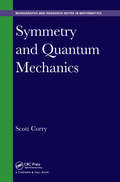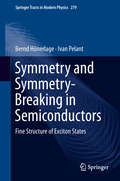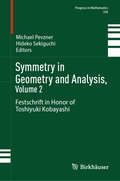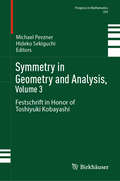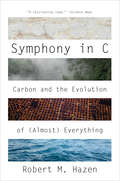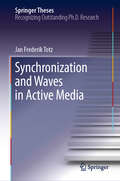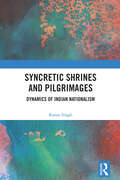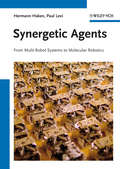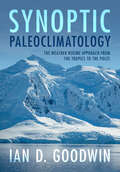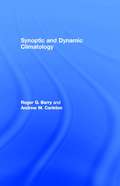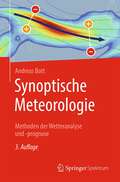- Table View
- List View
Switching on Plant Innate Immunity Signaling Systems
by P. VidhyasekaranThis book presents the ways and means to switch on plant immune signaling systems using PAMP-PIMP-PRR signaling complex for crop disease management. It also describes bioengineering approaches to develop transgenic plants expressing enhanced disease resistance using genes encoding PAMPs, PRRs and transcription factors and genes involved in generation of PIMPs/HAMPs. It also discusses recent commercial development of PAMP products to switch on plant innate immunity for crop disease management. These unique approaches have been described with more than 100 figures and illustrations and these would make this book attractive for researchers and students to buy this book.
Symbiotic Soil Microorganisms: Biology and Applications (Soil Biology #60)
by Ajit Varma Neeraj Shrivastava Shubhangi MahajanThis book explores microbial symbiosis, with a particular focus on soil microorganisms, highlighting their application in enhancing plant growth and yield. It addresses various types of bacterial and fungal microbes associated with symbiotic phenomena, including rhizobium symbiosis, arbuscular mycorrhizal symbiosis, ectomycorrhizal symbiosis, algal/lichen symbiosis, and Archeal symbiosis.Presenting strategies for employing a diverse range of bacterial and fungal symbioses in nutrient fortification, adaptation of plants in contaminated soils, and mitigating pathogenesis, it investigates ways of integrating diverse approaches to increase crop production under the current conventional agroecosystem.Providing insights into microbial symbioses and the challenges of adopting a plant-microbe synergistic approach towards plant health, this book is a valuable resource for researchers, graduate students and anyone in industry working on bio-fertilizers and their agricultural applications.
Symbol Correspondences for Spin Systems
by Pedro de M. Rios Eldar StraumeIn mathematical physics, the correspondence between quantum and classical mechanics is a central topic, which this book explores in more detail in the particular context of spin systems, that is, SU(2)-symmetric mechanical systems. A detailed presentation of quantum spin-j systems, with emphasis on the SO(3)-invariant decomposition of their operator algebras, is first followed by an introduction to the Poisson algebra of the classical spin system and then by a similarly detailed examination of its SO(3)-invariant decomposition. The book next proceeds with a detailed and systematic study of general quantum-classical symbol correspondences for spin-j systems and their induced twisted products of functions on the 2-sphere. This original systematic presentation culminates with the study of twisted products in the asymptotic limit of high spin numbers. In the context of spin systems it shows how classical mechanics may or may not emerge as an asymptotic limit of quantum mechanics. The book will be a valuable guide for researchers in this field and its self-contained approach also makes it a helpful resource for graduate students in mathematics and physics.
Symbolic Dynamical Systems and C*-Algebras: Continuous Orbit Equivalence of Topological Markov Shifts and Cuntz–Krieger Algebras (Mathematical Physics Studies)
by Kengo MatsumotoThis book presents the interplay between topological Markov shifts and Cuntz–Krieger algebras by providing notations, techniques, and ideas in detail. The main goal of this book is to provide a detailed proof of a classification theorem for continuous orbit equivalence of one-sided topological Markov shifts. The continuous orbit equivalence of one-sided topological Markov shifts is classified in terms of several different mathematical objects: the étale groupoids, the actions of the continuous full groups on the Markov shifts, the algebraic type of continuous full groups, the Cuntz–Krieger algebras, and the K-theory dates of the Cuntz–Krieger algebras. This classification result shows that topological Markov shifts have deep connections with not only operator algebras but also groupoid theory, infinite non-amenable groups, group actions, graph theory, linear algebras, K-theory, and so on. By using this classification result, the complete classification of flow equivalence in two-sided topological Markov shifts is described in terms of Cuntz–Krieger algebras. The author will also study the relationship between the topological conjugacy of topological Markov shifts and the gauge actions of Cuntz–Krieger algebras.
Symmetrien in der Physik: Gruppen- und Darstellungstheorie mit Anwendungen
by Andreas WipfDas vorliegende Buch führt durch die Symmetrien in der Physik: Es werden wichtige Gruppen und Symmetrien aus der Molekülphysik, der Festkörperphysik und (Quanten-)Feldtheorie vorgestellt und behandelt. Das Buch richtet sich an Studierende der Physik, die entweder die Vorlesung zur Gruppen- und Darstellungstheorie hören oder sich im Rahmen einer Bachelor-, Master- oder Doktorarbeit in Gruppentheorie und Symmetrien in der Physik einlesen möchten. Behandelt werden u.a. endliche und kontinuierliche Gruppen sowie Lie-Algebren und deren Darstellungen, aber auch klassische und quantisierte Feldtheorien, Eichtheorien und konforme Feldtheorien. Der Autor verbindet in den Kapiteln die mathematischen Grundlagen mit der physikalischen Anwendung. Beispiele, Aufgaben und Zwischenfragen helfen Leserinnen und Lesern dabei, ihr Verständnis zu überprüfen..
Symmetries in Atomic Nuclei
by Pieter Van Isacker Jan Jolie Alejandro FrankSymmetries in Atomic Nuclei aims to present an overview of recent applications of symmetry to the description of atomic nuclei. Special care is given to a pedagogical introduction of symmetry concepts using simple examples. After a historical overview of the applications of symmetry in nuclear physics, progress in the field during the last decade is reviewed. Special emphasis is put on the introduction of neutron-proton and boson-fermion degrees of freedom. Their combination leads to a supersymmetric description of pairs and quartets of nuclei. Both theoretical aspects and experimental signatures of dynamical (super)symmetries are carefully discussed. Case studies show how these symmetries are displayed by real atomic nuclei which have been studied experimentally using state-of-the art spectroscopy. This book focuses on nuclear structure physics and has been written by active investigators in the field, but its scope is wider and is intended for final-year or post-graduate students and researchers interested in understanding the power and beauty of symmetry methods in physics.
Symmetries in Atomic Nuclei: From Isospin to Supersymmetry (Springer Tracts in Modern Physics #230)
by Jan Jolie Alejandro Frank Pieter Van IsackerThe revised edition of this established work presents an extended overview of recent applications of symmetry to the description of atomic nuclei, including a pedagogical introduction to symmetry concepts using simple examples. Following a historical overview of the applications of symmetry in nuclear physics, attention turns to more recent progress in the field. Special emphasis is placed on the introduction of neutron-proton and boson-fermion degrees of freedom. Their combination leads to a supersymmetric description of pairs and quartets of nuclei. Expanded and updated throughout, the book now features separate chapters on the nuclear shell model and the interacting boson model, the former including discussion of recent results on seniority in a single-j shell. Both theoretical aspects and experimental signatures of dynamical (super)symmetries are carefully discussed. This book focuses on nuclear structure physics, but its broad scope makes it suitable for final-year or post-graduate students and researchers interested in understanding the power and beauty of symmetry methods in physics.Review of the 1st Edition:"The subject of this book, symmetries in physical systems, with particular focus on atomic nuclei, is of the utmost importance in modern physical science. In contrast to most treatments, frequently characterized by fearsome formalism, this book leads the reader step-by-step, in an easily understandable way, through this fascinating field...this book is remarkably accessible to both theorists and experimentalists. Indeed, I view it as essential reading for experimental nuclear structure physicists. This is one of the finest volumes on this subject I have ever encountered." Prof. R.F. Casten, Yale University
Symmetries in Fundamental Physics (Fundamental Theories of Physics #176)
by Kurt SundermeyerOver the course of the last century it has become clear that both elementary particle physics and relativity theories are based on the notion of symmetries. These symmetries become manifest in that the "laws of nature" are invariant under spacetime transformations and/or gauge transformations. The consequences of these symmetries were analyzed as early as in 1918 by Emmy Noether on the level of action functionals. Her work did not receive due recognition for nearly half a century, but can today be understood as a recurring theme in classical mechanics, electrodynamics and special relativity, Yang-Mills type quantum field theories, and in general relativity. As a matter of fact, as shown in this monograph, many aspects of physics can be derived solely from symmetry considerations. This substantiates the statement of E.P.Wigner "... if we knew all the laws of nature, or the ultimate Law of nature, the invariance properties of these laws would not furnish us new information." Thanks to Wigner we now also understand the implications of quantum physics and symmetry considerations: Poincare invariance dictates both the characteristic properties of particles (mass, spin, ...) and the wave equations of spin 0, 1/2, 1, ... objects. Further, the work of C.N.Yang and R.Mills reveals the consequences of internal symmetries as exemplified in the symmetry group of elementary particle physics. Given this pivotal role of symmetries it is thus not surprising that current research in fundamental physics is to a great degree motivated and inspired by considerations of symmetry.The treatment of symmetries in this monograph ranges from classical physics to now well-established theories of fundamental interactions, to the latest research on unified theories and quantum gravity.
Symmetries of Integro-Differential Equations: With Applications in Mechanics and Plasma Physics
by N. Kh. Ibragimov Sergey V. Meleshko Yurii N. Grigoriev Vladimir F. KovalevThis book aims to coherently present applications of group analysis to integro-differential equations in an accessible way. The book will be useful to both physicists and mathematicians interested in general methods to investigate nonlinear problems using symmetries. Differential and integro-differential equations, especially nonlinear, present the most effective way for describing complex processes. Therefore, methods to obtain exact solutions of differential equations play an important role in physics, applied mathematics and mechanics. This book provides an easy to follow, but comprehensive, description of the application of group analysis to integro-differential equations. The book is primarily designed to present both fundamental theoretical and algorithmic aspects of these methods. It introduces new applications and extensions of the group analysis method. The authors have designed a flexible text for postgraduate courses spanning a variety of topics.
Symmetries, Differential Equations and Applications: Sdea-iii, Istanbul, Turkey, January 2017 (Springer Proceedings in Mathematics & Statistics #266)
by Pavel Winternitz Peter J. Olver Victor G. Kac Teoman ÖzerBased on the third International Conference on Symmetries, Differential Equations and Applications (SDEA-III), this proceedings volume highlights recent important advances and trends in the applications of Lie groups, including a broad area of topics in interdisciplinary studies, ranging from mathematical physics to financial mathematics. The selected and peer-reviewed contributions gathered here cover Lie theory and symmetry methods in differential equations, Lie algebras and Lie pseudogroups, super-symmetry and super-integrability, representation theory of Lie algebras, classification problems, conservation laws, and geometrical methods. The SDEA III, held in honour of the Centenary of Noether’s Theorem, proven by the prominent German mathematician Emmy Noether, at Istanbul Technical University in August 2017 provided a productive forum for academic researchers, both junior and senior, and students to discuss and share the latest developments in the theory and applications of Lie symmetry groups. This work has an interdisciplinary appeal and will be a valuable read for researchers in mathematics, mechanics, physics, engineering, medicine and finance.
Symmetries, Integrable Systems and Representations
by Sophie Morier-Genoud Kenji Iohara Bertrand RémyThis volume is the result of two international workshops; Infinite Analysis 11 - Frontier of Integrability - held at University of Tokyo, Japan in July 25th to 29th, 2011, and Symmetries, Integrable Systems and Representations held at Université Claude Bernard Lyon 1, France in December 13th to 16th, 2011. Included are research articles based on the talks presented at the workshops, latest results obtained thereafter, and some review articles. The subjects discussed range across diverse areas such as algebraic geometry, combinatorics, differential equations, integrable systems, representation theory, solvable lattice models and special functions. Through these topics, the reader will find some recent developments in the field of mathematical physics and their interactions with several other domains.
Symmetry Breaking: A Non-perturbative Outlook (Theoretical and Mathematical Physics #732)
by Franco StrocchiThe third edition of the by now classic reference on rigorous analysis of symmetry breaking in both classical and quantum field theories adds new topics of relevance, in particular the effect of dynamical Coulomb delocalization, by which boundary conditions give rise to volume effects and to energy/mass gap in the Goldstone spectrum (plasmon spectrum, Anderson superconductivity, Higgs phenomenon). The book closes with a discussion of the physical meaning of global and local gauge symmetries and their breaking, with attention to the effect of gauge group topology in QCD. From the reviews of the first edition: It is remarkable to see how much material can actually be presented in a rigorous way (incidentally, many of the results presented are due to Strocchi himself), yet this is largely ignored, the original heuristic derivations being, as a rule, more popular. - At each step he strongly emphasizes the physical meaning and motivation of the various notions introduced [...] a book that fills a conspicuous gap in the literature, and does it rather well. It could also be a good basis for a graduate course in mathematical physics. J.-P. Antoine, Physicalia 28/2, 2006 Despite many accounts in popular textbooks and a widespread belief, the phenomenon is rather subtle, requires an infinite set of degrees of freedom and an advanced mathematical setting of the system under investigation. [...] The mathematically oriented graduate student will certainly benefit from this thorough, rigorous and detailed investigation. G. Roepstorff, Zentralblatt MATH, Vol. 1075, 2006 From the reviews of the second edition: This second edition of Strocchi’s Symmetry Breaking presents a complete, generalized and highly rigorous discussion of the subject, based on a formal analysis of conditions necessary for the mechanism of spontaneous symmetry breaking to occur in classical systems, as well as in quantum systems. […] This book is specifically recommended for mathematical physicists interested in a deeper and rigorous understanding of the subject, and it should be mandatory for researchers studying the mechanism of spontaneous symmetry breaking. S. Hajjawi, Mathematical Reviews, 2008
Symmetry and Quantum Mechanics (Chapman & Hall/CRC Monographs and Research Notes in Mathematics)
by Scott CorryStructured as a dialogue between a mathematician and a physicist, Symmetry and Quantum Mechanics unites the mathematical topics of this field into a compelling and physically-motivated narrative that focuses on the central role of symmetry. Aimed at advanced undergraduate and beginning graduate students in mathematics with only a minimal background in physics, this title is also useful to physicists seeking a mathematical introduction to the subject. Part I focuses on spin, and covers such topics as Lie groups and algebras, while part II offers an account of position and momentum in the context of the representation theory of the Heisenberg group, along the way providing an informal discussion of fundamental concepts from analysis such as self-adjoint operators on Hilbert space and the Stone-von Neumann Theorem. Mathematical theory is applied to physical examples such as spin-precession in a magnetic field, the harmonic oscillator, the infinite spherical well, and the hydrogen atom.
Symmetry and Symmetry-Breaking in Semiconductors: Fine Structure of Exciton States (Springer Tracts in Modern Physics #279)
by Bernd Hönerlage Ivan PelantThis book discusses group theory investigations of zincblende and wurtzite semiconductors under symmetry-breaking conditions. The text presents the group theory elements required to develop a multitude of symmetry-breaking problems, giving scientists a fast track to bypass the need for recalculating electronic states. The text is not only a valuable resource for speeding up calculations but also illustrates the construction of effective Hamiltonians for a chosen set of electronic states in crystalline semiconductors. Since Hamiltonians have to be invariant under the transformations of the point group, the crystal symmetry determines the multiplet structure of these states in the presence of spin-orbit, crystal-field, or exchange interactions. Symmetry-breaking leads to additional coupling of the states, resulting in shifts and/or splittings of the multiplets. Such interactions may be intrinsic, as in the case of the quasi-particle dispersion, or extrinsic, induced by magnetic, electric, or strain fields. Using a power expansion of the perturbations these interaction terms can be determined in their parameterized form in a unique way. The hierarchic structure of this invariant development allows to estimate the importance of particular symmetry-breaking effects in the Hamiltonian. A number of selected experimental curves are included to illustrate the symmetry-based discussions, which are especially important in optical spectroscopy. This text is written for graduate students and researchers who want to understand and simulate experimental findings reflecting the fine structure of electronic or excitonic states in crystalline semiconductors.
Symmetry in Geometry and Analysis, Volume 2: Festschrift in Honor of Toshiyuki Kobayashi (Progress in Mathematics #358)
by Michael Pevzner Hideko SekiguchiSymmetry in Geometry and Analysis is a Festschrift honoring Toshiyuki Kobayashi. The three volumes feature 35 selected contributions from invited speakers of twin conferences held in June 2022 in Reims, France, and in September 2022 in Tokyo, Japan. These contributions highlight the profound impact of Prof. Kobayashi’s pioneering ideas, groundbreaking discoveries, and significant achievements in the development of analytic representation theory, noncommutative harmonic analysis, and the geometry of discontinuous groups beyond the Riemannian context, among other areas, over the past four decades. This second volume of the Festschrift contains original articles on analytic methods in representation theory of reductive Lie groups and related topics. Contributions are by Salem Ben Saïd, Valentina Casarino, Paolo Ciatti, Jean-Louis Clerc, Jan Frahm, Joachim Hilgert, Toshihisa Kubo, Khalid Koufany, Quentin Labriet, Karl-Hermann Neeb, Yury Neretin, Gestur Ólafsson, Bent Ørsted, Toshio Oshima, Birgit Speh, Jorge Vargas, and Clemens Weiske.
Symmetry in Geometry and Analysis, Volume 3: Festschrift in Honor of Toshiyuki Kobayashi (Progress in Mathematics #359)
by Michael Pevzner Hideko SekiguchiSymmetry in Geometry and Analysis is a Festschrift honoring Toshiyuki Kobayashi. The three volumes feature 35 selected contributions from invited speakers of twin conferences held in June 2022 in Reims, France, and in September 2022 in Tokyo, Japan. These contributions highlight the profound impact of Prof. Kobayashi’s pioneering ideas, groundbreaking discoveries, and significant achievements in the development of analytic representation theory, noncommutative harmonic analysis, and the geometry of discontinuous groups beyond the Riemannian context, among other areas, over the past four decades. This third volume of the Festschrift contains original articles on branching problems in representation theory of reductive Lie groups and related topics. Contributions are by Ali Baklouti, Hidenori Fujiwara, Dmitry Gourevitch, Masatoshi Kitagawa, Salma Nasrin, Yoshiki Oshima, and Petr Somberg.
Symphony in C (Almost) Everything: Carbon And The Evolution Of (almost) Everything
by Robert M. HazenA Science News Favorite Book of 2019 An earth scientist reveals the dynamic biography of the most resonant—and most necessary—chemical element on Earth. Carbon. It’s in the fibers in your hair, the timbers in your walls, the food that you eat, and the air that you breathe. It’s worth billions of dollars as a luxury and half a trillion as a necessity, but there are still mysteries about the element that can be both diamond and coal. Where does it come from, what does it do, and why, above all, does life need it? With poetic storytelling, Robert M. Hazen leads us on a global journey through the origin and evolution of life’s most essential and ubiquitous element.
Synchronization and Triggering: from Fracture to Earthquake Processes
by Roman Teisseyre Valerio De Rubeis Zbigniew CzechowskiThis monograph contains experimental and theoretical considerations on synchronization and triggering in laboratory fracture experiments and in earthquake processes. Non-linear dynamics and the physics of rotational motions reveal such ordering in geophysical processes and observed time series. Presented experiments with electromagnetic and mechanical forcing show synchronization of the slip instabilities observed as acoustic burst emissions. New observational results, based on a net of broadband seismic stations, indicate the hidden periodicities and multiple coherence effects in the low frequency microseismic oscillations observed tens of hours before the earthquakes. These results are supported by observational evidence on synchronization between shear oscillations and rotation motions in microseismic fields before earthquakes occur.
Synchronization and Waves in Active Media (Springer Theses)
by Jan Frederik TotzThe interplay between synchronization and spatio-temporal pattern formation is central for a broad variety of phenomena in nature, such as the coordinated contraction of heart tissue, associative memory and learning in neural networks, and pathological synchronization during Parkinson disease or epilepsy. In this thesis, three open puzzles of fundametal research in Nonlinear Dynamics are tackled: How does spatial confinement affect the dynamics of three-dimensional vortex rings? What role do permutation symmetries play in the spreading of excitation waves on networks? Does the spiral wave chimera state really exist?All investigations combine a theoretical approach and experimental verification, which exploit an oscillatory chemical reaction. A novel experimental setup is developed that allows for studying networks with N > 1000 neuromorphic relaxation oscillators. It facilitates the free choice of network topology, coupling function as well as its strength, range and time delay, which can even be chosen as time-dependent. These experimental capabilities open the door to a broad range of future experimental inquiries into pattern formation and synchronization on large networks, which were previously out of reach.
Syncretic Shrines and Pilgrimages: Dynamics of Indian Nationalism
by Karan SinghThis book looks at various syncretic traditions in India, such as Bhakti, Nath Yogi, Sufi, Imam Shahi, Ismailis, Khojas and others, and presents an elaborate picture of a redefined cultural space through them. It also investigates different syncretisms - Hindu-Muslim, Hindu-Muslim-Christian and Aboriginal-Ethnic - to understand diverse aspects of hybridity within the Indian nation space. It discusses how Indian nationalism was composed of different opinions from its inception, reflecting its rich diversity and pluralistic traditions. The book traces the emergence of multiple contours of Indian nationalism through the historical trajectory of religious diversity, lingering effects of colonialism, and experimentation with secularism. This volume caters to scholars and students interested in cultural studies, religion studies, pilgrimage studies, history, social anthropology, historical sociology, historical geography, religion and art history. It will also be of interest to political theorists and general readers.
Synergetic Agents: From Multi-Robot Systems to Molecular Robotics
by Paul Levi Hermann HakenThis book addresses both multi robot systems and miniaturization to the nanoscale from a unifying point of view, but without leaving aside typical particularities of either. The unifying aspect is based on the concept of information minimization whose precise formulation is the Haken-Levi-principle. The authors introduce basic concepts of multi-component self-organizing systems such as order parameters (well known from equilibrium and non-equilibrium phase transitions) and the slaving principle (which establishes a link to dynamical systems). Among explicit examples is the docking manoeuvre of two robots in two and three dimensions. The second part of the book deals with the rather recently arising field of molecular robotics. It is particularly here where nature has become a highly influential teacher for the construction of robots. In living biological cells astounding phenomena occur: there are molecules (proteins) that literally walk on polymer strands and transport loads that are heavier than their carriers, or molecules that, by joint action, contract muscles. The book provides the reader with an insight into these phenomena, especially by a detailed theoretical treatment of the molecular mechanism of muscle contraction. At the molecular level, for an appropriate approach the use of quantum theory is indispensable. The authors introduce and use it in a form that avoids all the clumsy calculations of wave-functions. They present a model which is based on an elementary version of quantum field theory and allows taking into account the impact of the surrounding on the quantum mechanical activity of a single molecule. By presenting explicit and pedagogical examples, the reader gets acquainted with the appropriate modelling of the walking behaviour of single molecular robots and their collective behaviour. The further development of multi-robot systems and particularly of molecular robots will require the cooperation of a variety of disciplines. Therefore the book appeals to a wide audience including researchers, instructors, and advanced graduate students.
Synoptic Meteorology: Fundamentals of Weather Analysis and Forecasting
by Shaowen Shou Shenshen LiThis book introduces the principle and methodology of synoptic meteorology, which is an important branch of meteorology, studying on the weather analysis and forecasting. The content includes the features of meteorological fields and their kinetics; the basic laws controlling atmospheric motions; the relationship between wind field and pressure-temperature fields; the air masses and fronts; the cyclone and anti-cyclones; the general atmospheric circulations; forecasting of synoptic situation ,and the diagnostic analysis of weather.
Synoptic Paleoclimatology: The Weather Regime Approach from the Tropics to the Poles
by Ian D. GoodwinProjecting regional climate change over this century and the next remains challenging due to the chaotic nature of weather, but it is made more reliable through reconstructions of paleoweather in relation to climate change in atmospheric and ocean circulation, winds, waves, currents, and precipitation. This primer applies a cross-disciplinary treatment of large-scale and synoptic climatology to the reconstruction of past climates under the umbrella of synoptic paleoclimatology, providing the theory and application of synoptic paleoclimatology for the study and prediction of future climate evolution. Climate proxy and data–model assimilation methodologies are described in detail, focusing on coasts, the surface ocean, glaciers, and ice sheets. This book also presents a state-of-the-art synthesis of regional climate history across the Southern Hemisphere, including tropical coral reefs, coasts, alpine glaciers, and Antarctica. This book will be invaluable to advanced students, researchers, and practitioners in climatology, paleoclimatology, meteorology, coastal geoscience, glaciology, oceanography, global change, and climate risk assessment.
Synoptic and Dynamic Climatology
by Roger G. Barry Andrew M. CarletonSynoptic and Dynamic Climatology provides the first comprehensive account of the dynamical behaviour and mechanisms of the global climate system and its components, together with a modern survey of synoptic-scale weather systems in the tropics and extratropics, and of the methods and applications of synoptic climate classification. It is unrivalled in the scope and detail of its contents. The work is thoroughly up to date, with extensive bibliographies by chapter. It is illustrated with nearly 300 figures and plates.*Part 1 provides an introduction to the global climate system and the space-time scales of weather and climate processes, followed by a chapter on climate data and their analysis*Part 2 describes and explains the characteristics of the general circulation of the global atmosphere and includes the nature and causes of global teleconnection patterns*Part 3 discusses synoptic weather systems in the extratropics and tropics and satellite-based climatologies of synoptic features. It also describes the applications of synoptic climatology and summarises current climatic research and its directions.
Synoptische Meteorologie: Methoden der Wetteranalyse und -prognose
by Andreas BottDas vorliegende Buch beschäftigt sich mit der synoptischen Meteorologie mittlerer Breiten im europäischen Raum. Hierbei wird versucht, die in der angewandten synoptischen Meteorologie interessanten Fragestellungen mit Hilfe der Erkenntnisse aus der theoretischen Meteorologie zu erklären und auf diese Weise eine Verbindung zwischen theoretischer und angewandter Meteorologie zu schaffen. Zunächst erfolgt eine detaillierte Darstellung moderner Beobachtungs- und Messverfahren zur Beschreibung des momentanen atmosphärischen Zustands. Hierzu gehören u.a. die Vorstellung des Stationsmodells sowie die Wolkenklassifikation nach Vorgaben der World Meteorological Organization. Ein Schwerpunkt liegt auf der ausführlichen Diskussion der Mess- und Beobachtungsmethoden auf dem Gebiet der Satelliten- und Radarmeteorologie. Dies geschieht vornehmlich anhand der mit dem europäischen Wettersatellitensystem Meteosat Second Generation gewonnenen Daten und dem vom Deutschen Wetterdienst errichteten Radarverbund zur flächendeckenden Niederschlagserfassung innerhalb Deutschlands. Im weiteren Verlauf des Buchs werden die zur Beschreibung des thermo-hydrodynamischen Zustands der Atmosphäre notwendigen mathematischen Gleichungssysteme vorgestellt und interpretiert. Begriffe wie Hydrostasie, geostrophischer und ageostrophischer Wind, Divergenz, Vorticity sowie unterschiedliche Formen atmosphärischer Instabilitäten werden eingeführt und anhand zahlreicher Anwendungsbeispiele eingehend erörtert. Weitere Schwerpunkte der theoretischen Betrachtungen sind die quasi-geostrophische Theorie sowie die isentrope potentielle Vorticity, die eine Schlüsselgröße in der atmosphärischen Dynamik spielt. Im Anschluss daran erfolgt eine eingehende Diskussion der wichtigsten atmosphärischen Prozesse auf der synoptischen Skala, angefangen bei den Rossby-Wellen, über die darin eingebetteten Zyklonen und Antizyklonen, bis zu den mit der Zyklogenese einhergehenden Frontensystemen. Abschließend widmet sich das Buch mesoskaligen Wetterphänomenen, wie der Bildung von Gewitterzellen, Konvergenzlinien und Nebel.Das Buch richtet sich in erster Linie an Personen, die ein tiefergehendes Verständnis großräumiger atmosphärischer Prozesse anstreben und hierfür die mathematisch-physikalischen Grundprinzipien und Methoden der Meteorologie verwenden möchten.
